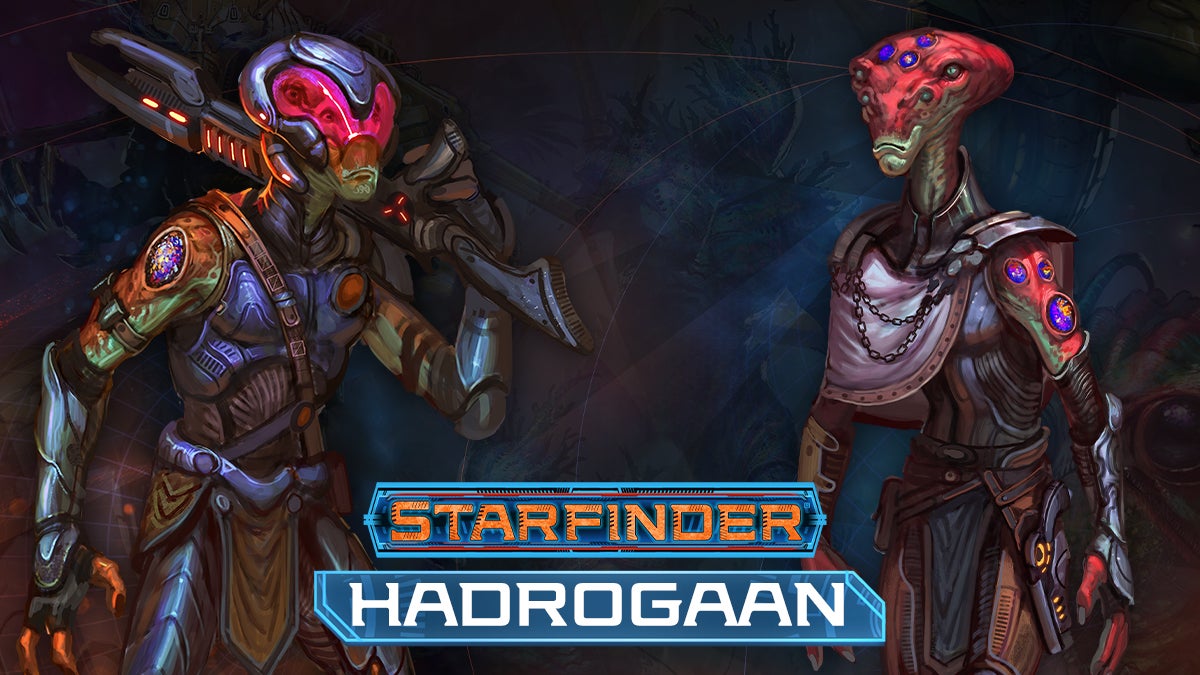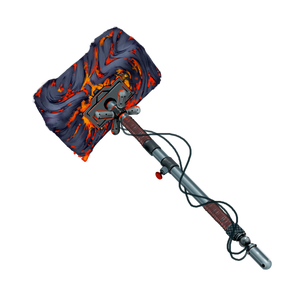
The new Starfinder Alien Archive 4 brings nearly 100 life-forms, a dozen playable races, and new alien technology. In the last part of this series let’s take a closer look at one of those species, the symbiotic hadrogaans, and some of that tech!
Though now the symbiotic primary inhabitants of the three moons of Hadrogess—a desolate world in the Vast— Hadrogaans once lived on the planet itself, millennia ago. They possess knowledge of their life on Hadrogess’s surface, and their departure from it, that date back to before the Gap, but even so, much of that history has been lost. Obsessive historians have reconstructed pieces of their history, but uncertainties and inconsistencies still plague the field.
All hadrogaans know for sure is that some catastrophe caused the planet’s atmosphere to begin slowly leaking into space. Faced with extinction, they scrambled for a possible solution. Following a series of frantic and unsanctioned experiments, a team of fringe scientists discovered a sapient crystal that grew deep beneath the planet’s crust, one that could merge with a hadrogaan body in a process that—in most cases— led to greater intellect and insight. These scientists claimed that the crystalline organisms, collectively called kallestrine, not only willingly participated in these experiments, but that they had sent psychic signals to the scientists—leading the latter to discover them—and had even proposed merging the entire hadrogaan species with kallestrine. Successful merging caused a rapid processing-power expansion that many felt could propel the two organisms into a new era of enlightenment, and in fact, many hadrogaans saw this way as their only hope for salvation.
Modern hadrogaans know that most of their people accepted the merging and somehow found a way—before the advent of starships—to settle their planet’s three moons. In their new symbiotic forms, hadrogaans formed a society dedicated to science, philosophy, progress, and utilitarianism in all matters. Their advancements positioned them to embrace Drift travel soon after receiving Triune’s signal, and whenever possible, hadrogaans seek positive relations with alien life—but should peace talks fail, they have no qualms with swift and efficient military solutions.
Most hadrogaans stand at about 8 feet tall with long limbs, thin bodies, and elongated fingers. Large hollows perforate their torsos, limbs, and sometimes their necks and faces, each filled with glimmering crystals—the organism that hadrogaans merged with during the Gap. The merging altered the species’ genetic makeup, and hadrogaan children are born with these crystalline hollows, which can grow and shift over time.
Hadrogaan racial traits include Dual Nervous Systems and Hadrogaan Senses: The crystals in a hadrogaan’s body can sense subtle vibrations in the environment. A hadrogaan has blindsense.
Alien Archive 4 is filled with alien related technology!
A massive species of spaceborne plants inhabits the rocky rings of gas giants throughout the galaxy. Known to Pact Worlds scientists as greater ring roots, these creatures resemble immense, hirsute tubers bristling with gnarled tendrils and alien eyes. However, countless tragedies since the Gap have earned the infamous plant its more common name: the shipkiller bulb.
GRAVITY GRENADE: Level 2-12
Derived from the gravitational organs of shipkiller bulbs, gravity grenades generate a micro-singularity that pulls affected targets towards the detonation point. Creatures in the area move the listed distance toward the blast’s center if they fail a Fortitude saving throw. Unsecured, unattended items of 1 bulk or less automatically fail this save. The force is not powerful enough to move bigger objects, such as Large vehicles.

Despite being large, bipedal creatures, thermatrods use a knuckle-walking quadrupedal gait resembling a gorilla’s stride, though they occasionally stand on their back legs or use their arms to climb.
MAGMA SLEDGE
Inspired by the red-hot stony body of a thermatrod, magma sledges are the larger cousins of the more agile magma blades (Starfinder Armory 38). At first glance, a magma sledge seems like an analog weapon with a steel shaft and a head of solid stone. However, when the weapon powers on, cracks form along the surface show the magma hidden within, held in place with powerful magnetic fields. When slammed into a target, the intense heat and force can send even the most powerful opponents reeling. Factory floors that mass produce magma sledges are often swelteringly hot.

Populating Triaxian children’s horror tales, ursikkas roam the Triaxian wilderness during the wandering planet’s winter years.
URSIKKA HIDE ARMOR
Some of the most intrepid hunters seek out ursikkas—and wily scavengers often search the tundra for fallen ursikka bodies—to harvest their hides. Ursikka hides are light, supple, and have an insulating quality that traps body heat, making them an ideal material for cold weather gear and clothes. Talented armorsmiths can create flexible light armor from this leather, which grants cold resistance in addition to the benefits listed on the table below. Basic ursikka hide armor provides cold resistance 10, and the resistance increases to 15 and 20 for advanced and elite suits respectively.
The Alien Archive 4 Cover Artist was Remko Troost with Interior Artists: Trevor Brown, Dominik Derow, Tuan Duong Chu, Nicolas Espinoza, Michele Giorgi, Alexandre Honore, Geun Cheol Jang, Víctor Manuel Leza Moreno, Artur Nakhodkin, Vladislav Orlowski, Mirco Paganessi, Rashad Pozdnyakov, Henrik Rosenborg, Victor Rossi, Gin Sakalauskas, Ruslan Skifonich, Olli Slyusareva, Luca Sotgiu, Matias Tapia, and Remko Troost.
Don’t miss the previous parts of the series that focus on the astriapi, the copaxi, and entu three of the twelve new playable species. Find your path to friendship and science-fantasy adventure with Starfinder!
Adventures Ahead!